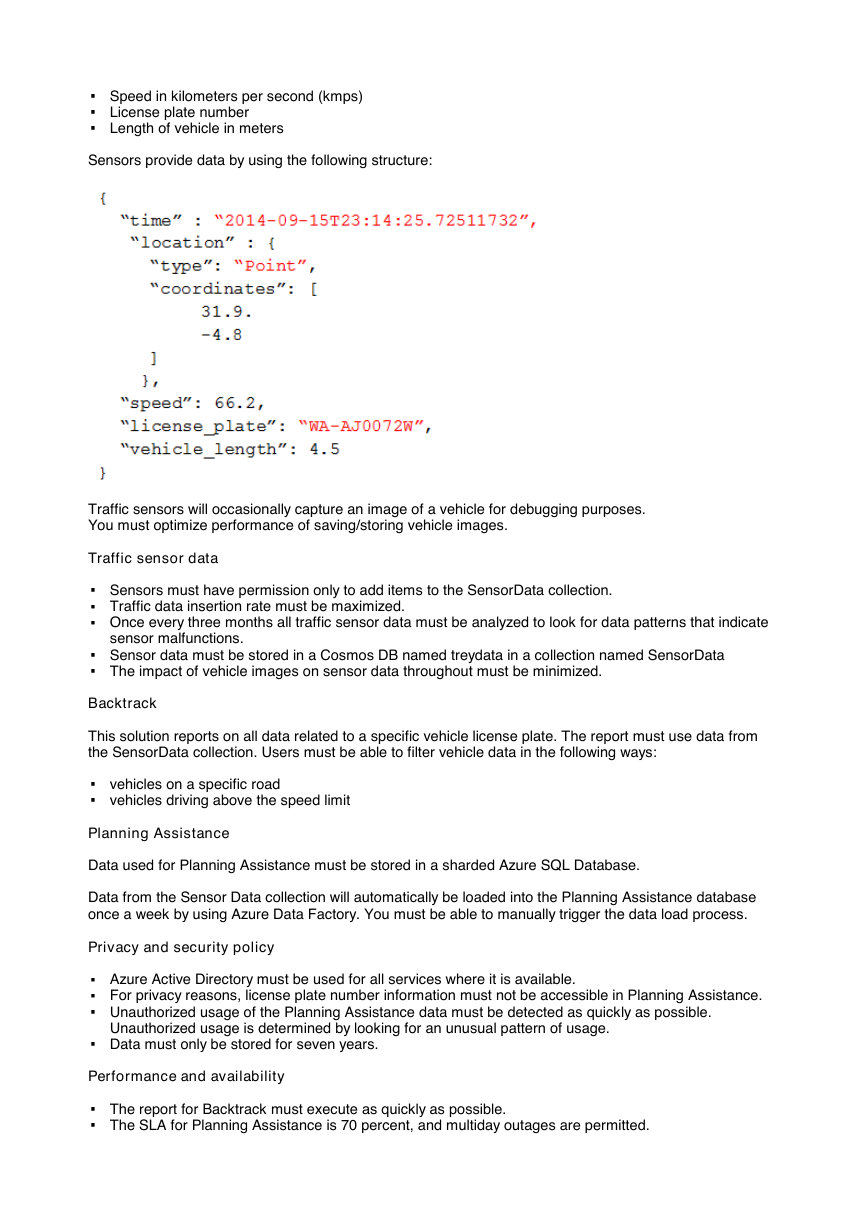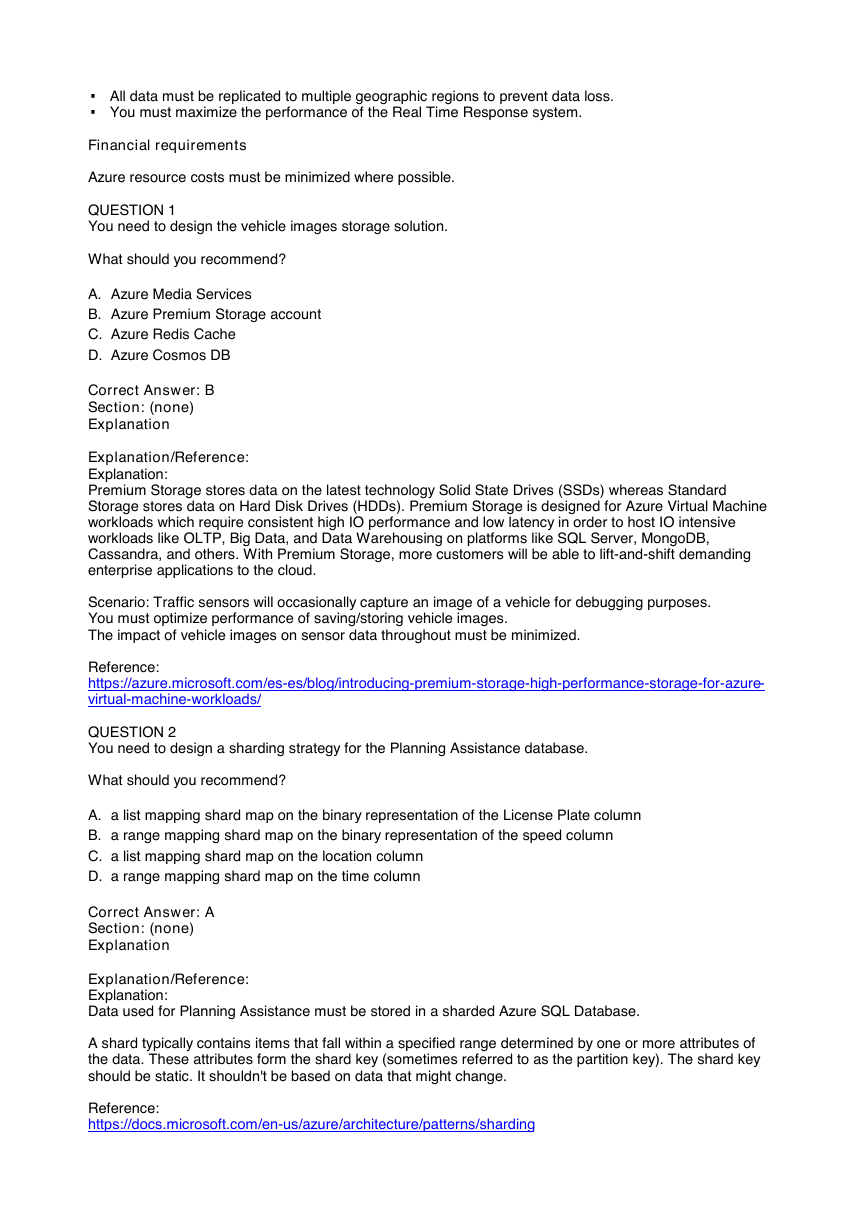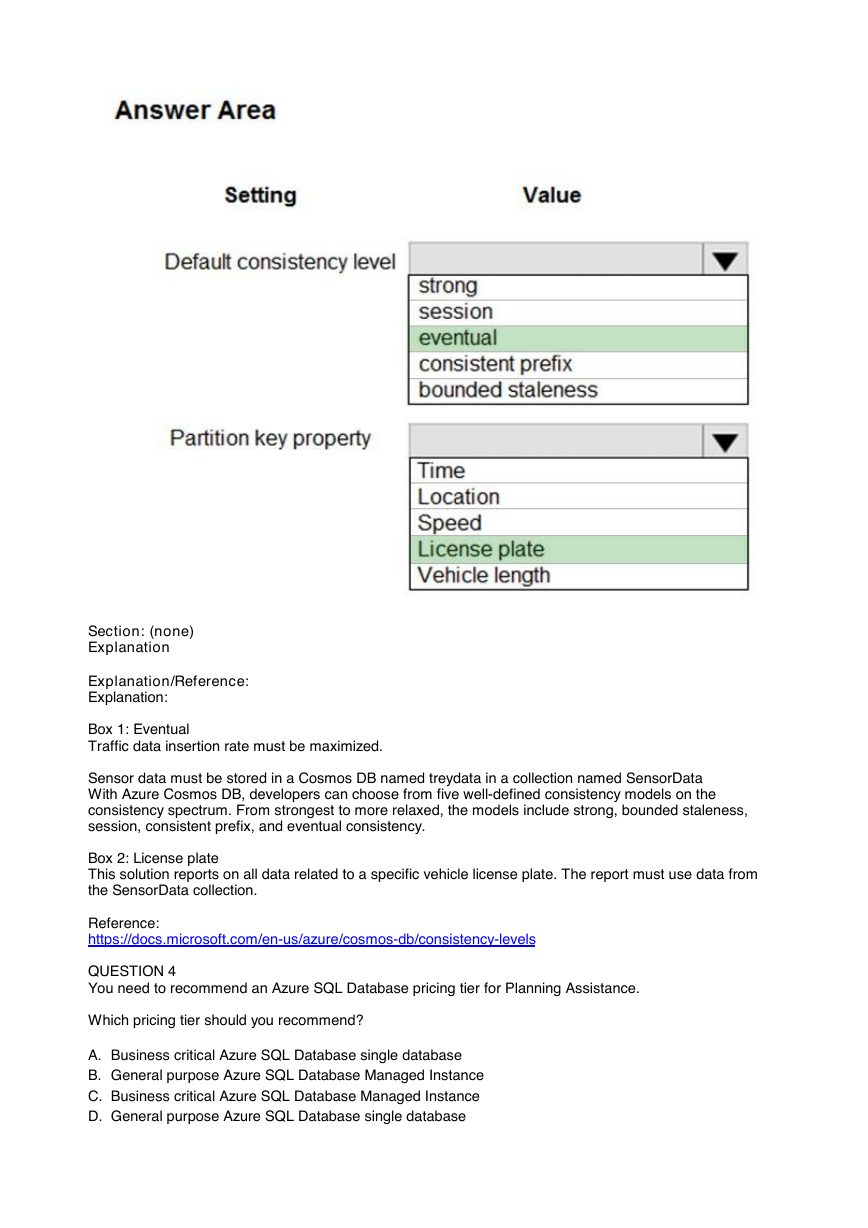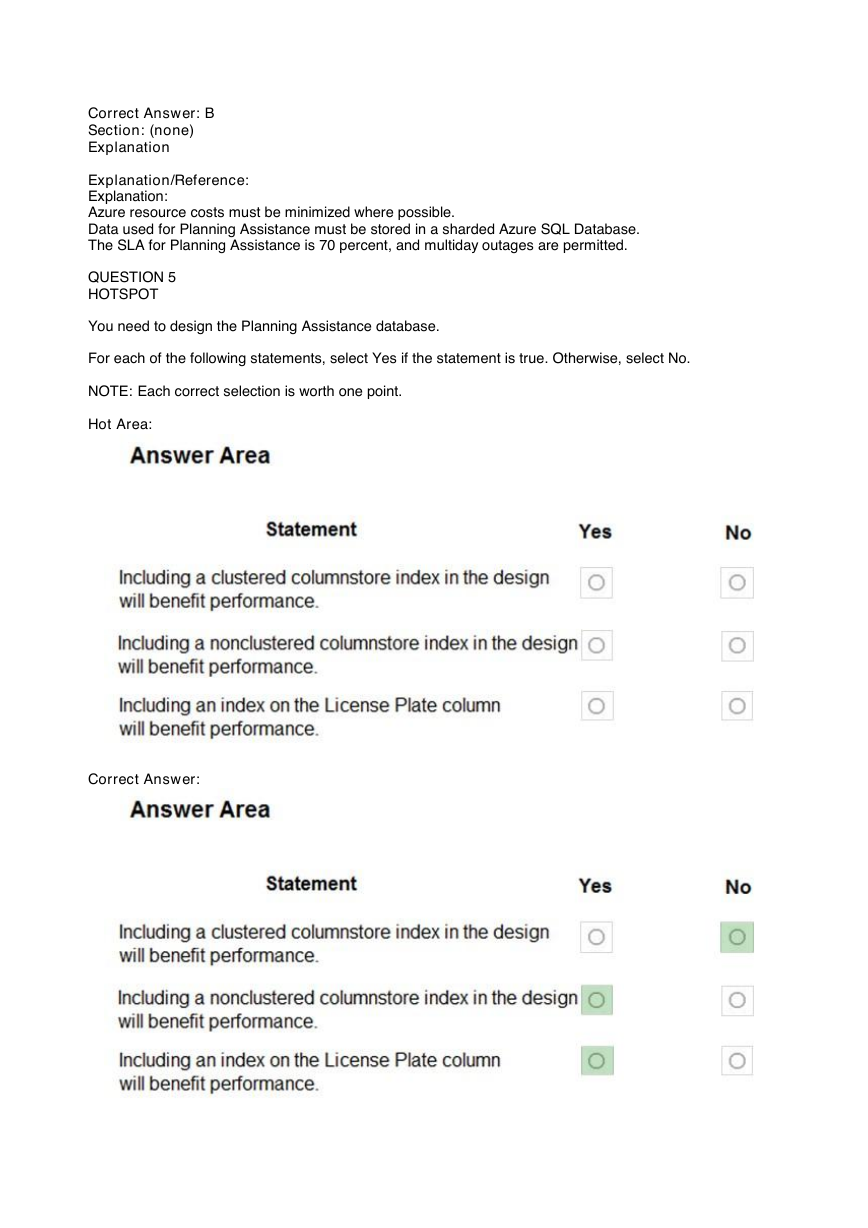DP-201
Designing an Azure Data Solution
302341CE5371968C6E29FD33D6E5E7D9
�
Design Azure data storage solutions
Testlet 1
Case study
This is a case study. Case studies are not timed separately. You can use as much exam time as you would
like to complete each case. However, there may be additional case studies and sections on this exam. You
must manage your time to ensure that you are able to complete all questions included on this exam in the
time provided.
To answer the questions included in a case study, you will need to reference information that is provided in
the case study. Case studies might contain exhibits and other resources that provide more information
about the scenario that is described in the case study. Each question is independent of the other questions
in this case study.
At the end of this case study, a review screen will appear. This screen allows you to review your answers
and to make changes before you move to the next section of the exam. After you begin a new section, you
cannot return to this section.
To start the case study
To display the first question in this case study, click the Next button. Use the buttons in the left pane to
explore the content of the case study before you answer the questions. Clicking these buttons displays
information such as business requirements, existing environment, and problem statements. If the case
study has an All Information tab, note that the information displayed is identical to the information
displayed on the subsequent tabs. When you are ready to answer a question, click the Question button to
return to the question.
Background
Trey Research is a technology innovator. The company partners with regional transportation department
office to build solutions that improve traffic flow and safety.
The company is developing the following solutions:
Regional transportation departments installed traffic sensor systems on major highways across North
America. Sensors record the following information each time a vehicle passes in front of a sensor:
Time
Location in latitude and longitude
302341CE5371968C6E29FD33D6E5E7D9
�
Speed in kilometers per second (kmps)
License plate number
Length of vehicle in meters
Sensors provide data by using the following structure:
Traffic sensors will occasionally capture an image of a vehicle for debugging purposes.
You must optimize performance of saving/storing vehicle images.
Traffic sensor data
Sensors must have permission only to add items to the SensorData collection.
Traffic data insertion rate must be maximized.
Once every three months all traffic sensor data must be analyzed to look for data patterns that indicate
sensor malfunctions.
Sensor data must be stored in a Cosmos DB named treydata in a collection named SensorData
The impact of vehicle images on sensor data throughout must be minimized.
Backtrack
This solution reports on all data related to a specific vehicle license plate. The report must use data from
the SensorData collection. Users must be able to filter vehicle data in the following ways:
vehicles on a specific road
vehicles driving above the speed limit
Planning Assistance
Data used for Planning Assistance must be stored in a sharded Azure SQL Database.
Data from the Sensor Data collection will automatically be loaded into the Planning Assistance database
once a week by using Azure Data Factory. You must be able to manually trigger the data load process.
Privacy and security policy
Azure Active Directory must be used for all services where it is available.
For privacy reasons, license plate number information must not be accessible in Planning Assistance.
Unauthorized usage of the Planning Assistance data must be detected as quickly as possible.
Unauthorized usage is determined by looking for an unusual pattern of usage.
Data must only be stored for seven years.
Performance and availability
The report for Backtrack must execute as quickly as possible.
The SLA for Planning Assistance is 70 percent, and multiday outages are permitted.
302341CE5371968C6E29FD33D6E5E7D9
�
All data must be replicated to multiple geographic regions to prevent data loss.
You must maximize the performance of the Real Time Response system.
Financial requirements
Azure resource costs must be minimized where possible.
QUESTION 1
You need to design the vehicle images storage solution.
What should you recommend?
A.Azure Media Services
B.Azure Premium Storage account
C.Azure Redis Cache
D.Azure Cosmos DB
Correct Answer: B
Section: (none)
Explanation
Explanation/Reference:
Explanation:
Premium Storage stores data on the latest technology Solid State Drives (SSDs) whereas Standard
Storage stores data on Hard Disk Drives (HDDs). Premium Storage is designed for Azure Virtual Machine
workloads which require consistent high IO performance and low latency in order to host IO intensive
workloads like OLTP, Big Data, and Data Warehousing on platforms like SQL Server, MongoDB,
Cassandra, and others. With Premium Storage, more customers will be able to lift-and-shift demanding
enterprise applications to the cloud.
Scenario: Traffic sensors will occasionally capture an image of a vehicle for debugging purposes.
You must optimize performance of saving/storing vehicle images.
The impact of vehicle images on sensor data throughout must be minimized.
Reference:
https://azure.microsoft.com/es-es/blog/introducing-premium-storage-high-performance-storage-for-azure-
virtual-machine-workloads/
QUESTION 2
You need to design a sharding strategy for the Planning Assistance database.
What should you recommend?
A.a list mapping shard map on the binary representation of the License Plate column
B.a range mapping shard map on the binary representation of the speed column
C.a list mapping shard map on the location column
D.a range mapping shard map on the time column
Correct Answer: A
Section: (none)
Explanation
Explanation/Reference:
Explanation:
Data used for Planning Assistance must be stored in a sharded Azure SQL Database.
A shard typically contains items that fall within a specified range determined by one or more attributes of
the data. These attributes form the shard key (sometimes referred to as the partition key). The shard key
should be static. It shouldn't be based on data that might change.
Reference:
https://docs.microsoft.com/en-us/azure/architecture/patterns/sharding
302341CE5371968C6E29FD33D6E5E7D9
�
QUESTION 3
HOTSPOT
You need to design the SensorData collection.
What should you recommend? To answer, select the appropriate options in the answer area.
NOTE: Each correct selection is worth one point.
Hot Area:
Correct Answer:
302341CE5371968C6E29FD33D6E5E7D9
�
Section: (none)
Explanation
Explanation/Reference:
Explanation:
Box 1: Eventual
Traffic data insertion rate must be maximized.
Sensor data must be stored in a Cosmos DB named treydata in a collection named SensorData
With Azure Cosmos DB, developers can choose from five well-defined consistency models on the
consistency spectrum. From strongest to more relaxed, the models include strong, bounded staleness,
session, consistent prefix, and eventual consistency.
Box 2: License plate
This solution reports on all data related to a specific vehicle license plate. The report must use data from
the SensorData collection.
Reference:
https://docs.microsoft.com/en-us/azure/cosmos-db/consistency-levels
QUESTION 4
You need to recommend an Azure SQL Database pricing tier for Planning Assistance.
Which pricing tier should you recommend?
A.Business critical Azure SQL Database single database
B.General purpose Azure SQL Database Managed Instance
C.Business critical Azure SQL Database Managed Instance
D. General purpose Azure SQL Database single database
302341CE5371968C6E29FD33D6E5E7D9
�
Correct Answer: B
Section: (none)
Explanation
Explanation/Reference:
Explanation:
Azure resource costs must be minimized where possible.
Data used for Planning Assistance must be stored in a sharded Azure SQL Database.
The SLA for Planning Assistance is 70 percent, and multiday outages are permitted.
QUESTION 5
HOTSPOT
You need to design the Planning Assistance database.
For each of the following statements, select Yes if the statement is true. Otherwise, select No.
NOTE: Each correct selection is worth one point.
Hot Area:
Correct Answer:
302341CE5371968C6E29FD33D6E5E7D9
�
Section: (none)
Explanation
Explanation/Reference:
Explanation:
Box 1: No
Data used for Planning Assistance must be stored in a sharded Azure SQL Database.
Box 2: Yes
Box 3: Yes
Planning Assistance database will include reports tracking the travel of a single vehicle
302341CE5371968C6E29FD33D6E5E7D9
�
















 2023年江西萍乡中考道德与法治真题及答案.doc
2023年江西萍乡中考道德与法治真题及答案.doc 2012年重庆南川中考生物真题及答案.doc
2012年重庆南川中考生物真题及答案.doc 2013年江西师范大学地理学综合及文艺理论基础考研真题.doc
2013年江西师范大学地理学综合及文艺理论基础考研真题.doc 2020年四川甘孜小升初语文真题及答案I卷.doc
2020年四川甘孜小升初语文真题及答案I卷.doc 2020年注册岩土工程师专业基础考试真题及答案.doc
2020年注册岩土工程师专业基础考试真题及答案.doc 2023-2024学年福建省厦门市九年级上学期数学月考试题及答案.doc
2023-2024学年福建省厦门市九年级上学期数学月考试题及答案.doc 2021-2022学年辽宁省沈阳市大东区九年级上学期语文期末试题及答案.doc
2021-2022学年辽宁省沈阳市大东区九年级上学期语文期末试题及答案.doc 2022-2023学年北京东城区初三第一学期物理期末试卷及答案.doc
2022-2023学年北京东城区初三第一学期物理期末试卷及答案.doc 2018上半年江西教师资格初中地理学科知识与教学能力真题及答案.doc
2018上半年江西教师资格初中地理学科知识与教学能力真题及答案.doc 2012年河北国家公务员申论考试真题及答案-省级.doc
2012年河北国家公务员申论考试真题及答案-省级.doc 2020-2021学年江苏省扬州市江都区邵樊片九年级上学期数学第一次质量检测试题及答案.doc
2020-2021学年江苏省扬州市江都区邵樊片九年级上学期数学第一次质量检测试题及答案.doc 2022下半年黑龙江教师资格证中学综合素质真题及答案.doc
2022下半年黑龙江教师资格证中学综合素质真题及答案.doc